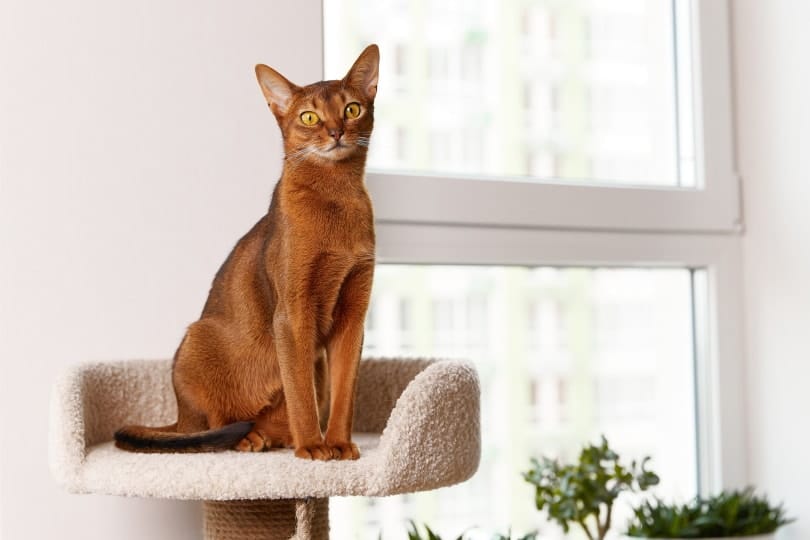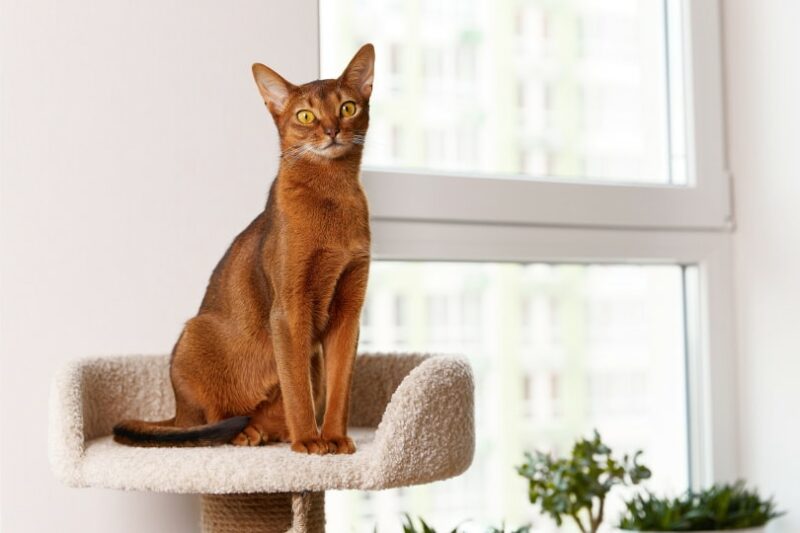Although the Abyssinian cat was developed in Great Britain in the late 19th century, the cat’s true origin is unknown. Its similarity to ancient Egyptian cats gave it the nickname “the cat of the Blue Nile,” but genetic research has linked the breed’s closest ancestor to Indian cats living near the Bay of Bengal. Abyssinians are playful, energetic cats who love playing with humans and other pets. The cats can live 15 years or more with adequate care, but they’re vulnerable to several medical conditions.
The 17 Common Abyssinian Cat Health Problems
1. Dental Disease
Dental disease is a common problem with Abyssinian cats, but it can be prevented with frequent brushing and periodic dental exams. Brushing a cat’s teeth is not a simple procedure, but your veterinarian can show you the proper technique. When food residue is not regularly removed, the buildup can form tartar on the teeth and gums. It eventually can cause the roots of the teeth and gums to be infected, and if left untreated, the disease can damage internal organs and cause teeth to fall out. Preventative care is essential to avoid dental disease because treating a chronic case can be expensive and stressful for the cat. Make sure you have good pet insurance when adopting or purchasing an Abyssinian cat.
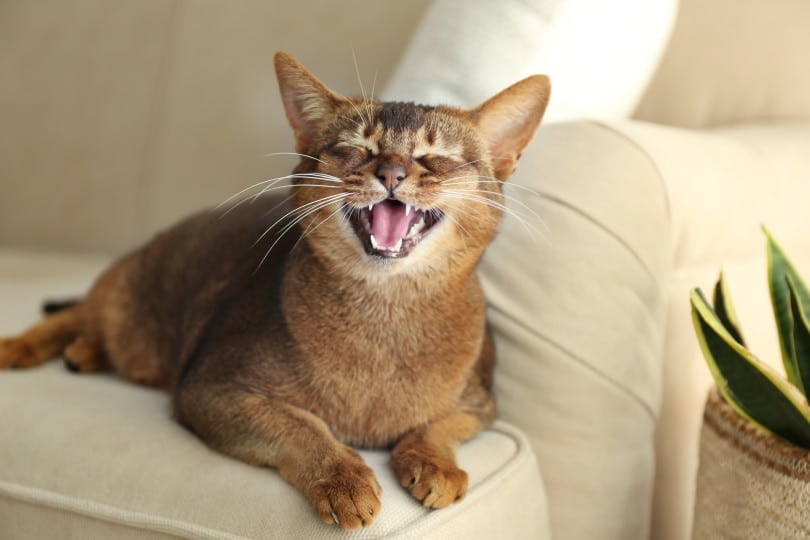
2. Heart Disease
Hypertrophic cardiomyopathy (HCM) can be caused by an inherited condition or other heart problems. When a cat’s overactive thyroid gland causes the heart’s left ventricle to become enlarged, the animal can experience breathing difficulty, loss of appetite, and lethargy. The disease affects males more than females and often occurs in cats who are 5 to 7 years old. Veterinarians have several medications to treat HCM, including beta-blockers, warfarin, furosemide, spironolactone, and nitroglycerin ointment. Patients are typically placed on a low-sodium diet and examined every 6 months with an ultrasound of the heart.
3. Arterial Thromboembolism
Arterial thromboembolism can occur when the cat’s heart is weakened by HCM or another heart disease. Blood clots develop in the enlarged left ventricle and travel into the circulatory system. If the clot impedes the blood flow, it can affect the organs, limbs, and brain. When the blood clot enters the aorta, it causes respiratory problems, pain, an inability to use the hind legs, and increased vocalization.
Veterinarians often use aggressive therapy to control pain and other symptoms, but some cats do not survive the disease when the clot enters the circulatory system. However, survivors of the initial blood clot can live a few years longer with effective treatment.
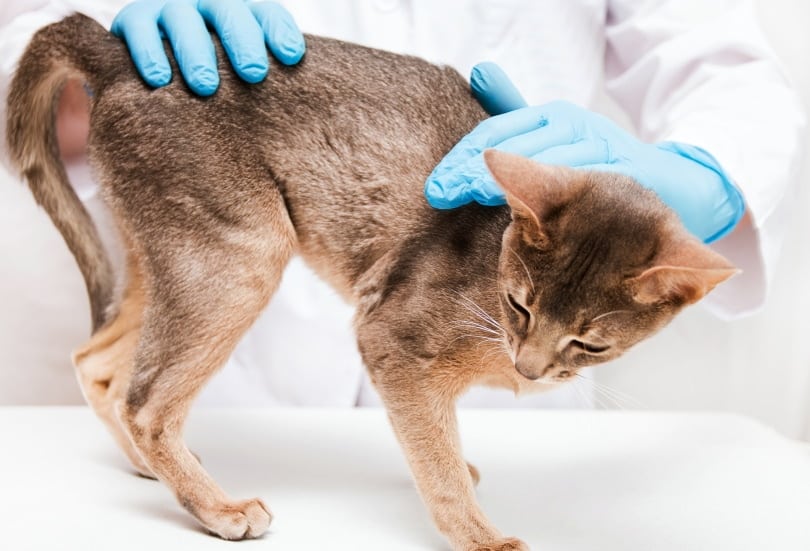
4. Cryptococcosis
Abyssinians, Siamese, and other cats with weakened immune systems are more vulnerable to contracting cryptococcosis. This fungal infection is caused by an infectious spore found in decaying vegetation and bird droppings. Cats living in Australia, Europe, and the Pacific Coast of the United States have experienced more cases of cryptococcosis than felines residing in other areas.
When the disease attacks the nasal cavity, it can cause swelling in the nose and face, breathing difficulty, appetite loss, weight loss, and chronic nasal discharge. If the disease spreads to the brain, it can lead to seizures, blindness, and spinal pain. With early treatment, cat’s suffering from cryptococcosis can make a full recovery.
5. Feline Infectious Peritonitis
Feline infectious peritonitis (FIP) often occurs in cats under 2 years old, but it can occur in felines of any age. Abyssinians, Birmans, Himalayans, Devon Rexes, Ragdolls, and cats living in multi-pet homes are more vulnerable to the disease than other felines. A strain of feline coronavirus that mutates is associated with FIP, but veterinarians have trouble diagnosing the disease because laboratory tests cannot distinguish between the FIP-causing coronavirus and other strains.
Symptoms can include decreased appetite, weight loss, fever, breathing problems, and a swollen abdomen. Treatments can extend a cat’s life when it suffers from FIP, but unfortunately, the disease is incurable and fatal.
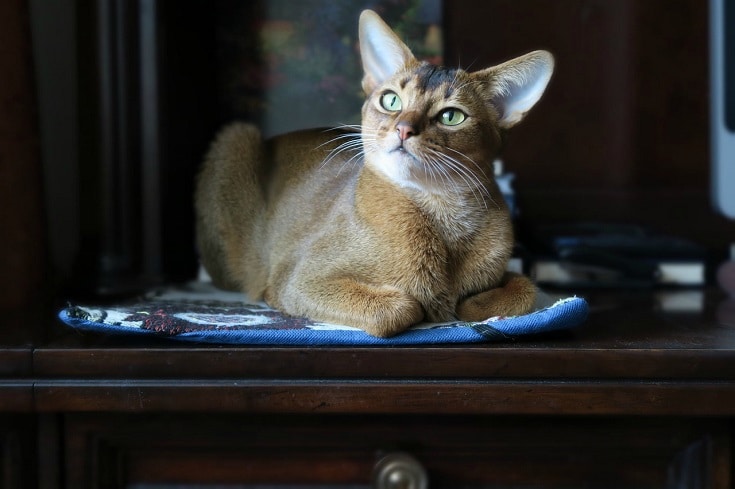
6. Neonatal Isoerythrolysis
When breeders are unaware of the blood types of their breeding pairs, a mother with type B blood can nurse a kitten with type A blood and pass on type A antigens that enter the kitten’s bloodstream. Kittens with the disease may appear healthy at first, but they can die suddenly in a few hours or days.
Abyssinians with type B blood are more susceptible to the disease than those with type A, and it’s essential to know your Abyssinian’s blood type to assess the risk of disease. Removing the kittens from the mother immediately so they can feed from a cat with the same blood type is one of the few treatments that can prevent death. However, the mortality rate of kittens suffering from the disease is high.
7. Pyruvate Kinase Deficiency
When the pyruvate kinase enzyme is deficient, it can prevent the cat’s red blood cells from metabolizing and cause anemia. Symptoms of the disease include weakness, pale mucous membranes, elevated heart rate, inability to exercise, and jaundice. Pyruvate kinase is connected to a genetic defect at birth, and Abyssinians and Somali cats are more vulnerable to the disease than other cats. The only effective treatment for the disease is a bone marrow transplant. The operation is expensive and risky, but cats can enjoy relatively normal lives after recovery.
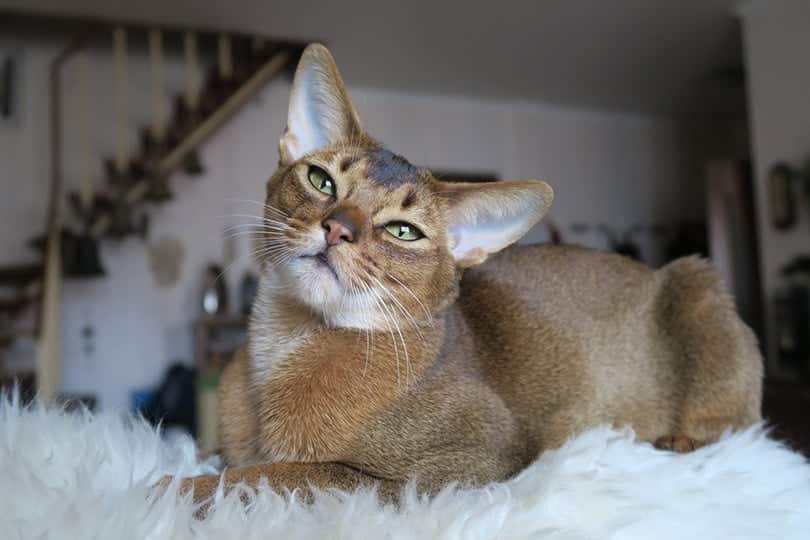
8. Increased Osmotic Fragility of Erythrocytes
A recently discovered form of anemia, increased osmotic fragility of erythrocytes, occurs more often in young Abyssinian and Somali cats. The rare disease results from an inherited erythrocyte defect, and most cats affected are younger than five years old. Osmotic fragility leads to the formation of abnormal red blood cells that can cause the spleen to become enlarged. Veterinarians can treat anemic cats with blood transfusions to extend their lives, but there are no cures for osmotic fragility.
9. Feline Lower Urinary Tract Disease (FLUTD)
Feline lower urinary tract disease refers to multiple conditions affecting the cat’s bladder or urethra. Symptoms of FLUTD may include crying while urinating, excessive genital licking, bloody urine, urinating in strange places, and straining to urinate. FLUTD can be caused by urinary stones, an infection, or feline idiopathic cystitis. Overweight, middle-aged cats and cats eating a dry diet are more vulnerable to FLUTD, but the disease can be treated with medications and surgery in extreme cases.
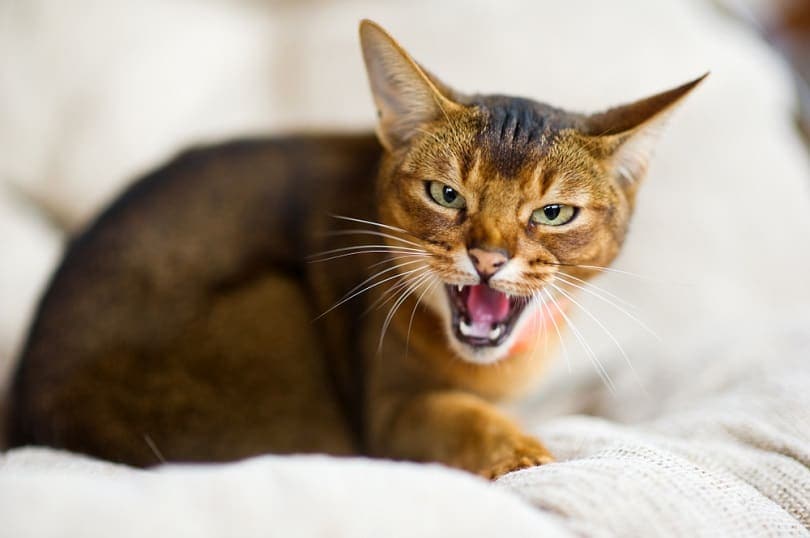
10. Renal Failure
Acute kidney failure in cats can be caused by trauma, kidney infections, poison ingestion, or heart failure. The condition is reversible if treated early, but there is no cure for chronic kidney failure. Older cats are more vulnerable to renal issues, but the disease can occur at any age. Symptoms of renal failure include constipation, frequent urination, vomiting, diarrhea, bad breath, weakness, and mouth ulcers. Although a chronic illness is not curable, veterinarians can treat the symptoms with medications, fluid injections, and surgery to extend the cat’s lifespan.
11. Amyloidosis
A chronic illness or infection can cause amyloidosis in cats, but the disease is rare in most breeds except the Siamese, Abyssinian, Tonkinese, Burmese, Oriental Shorthair, and Devon Rex. The condition occurs when the amyloid protein disrupts the normal functions of organs and tissues. Amyloidosis can affect different organs, but the disease is often associated with kidney and liver disease. When the kidneys are infected with amyloidosis, most cats live less than 12 months. However, felines with milder cases can have healthy lives with regular examinations by a veterinarian.
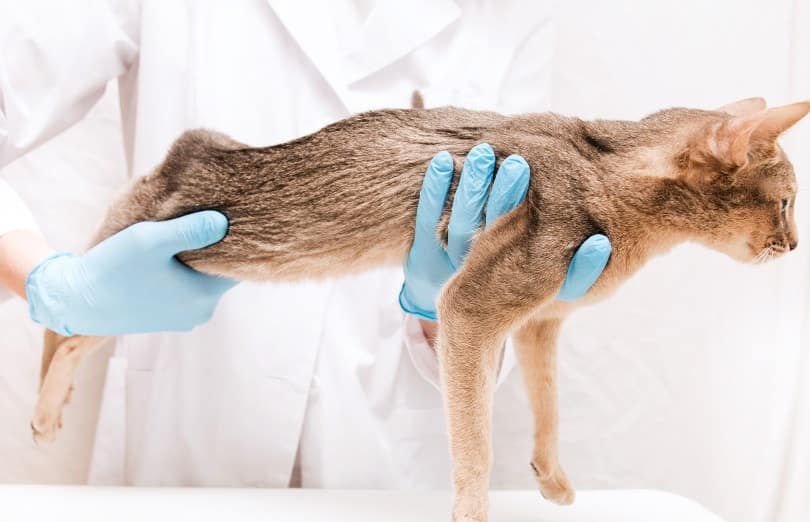
12. Patellar Luxation
The Abyssinian and Devon Rex cats are more vulnerable to patellar luxation than other breeds. The disease occurs when the kneecap is dislocated from its normal position, caused by trauma or a genetic condition. Patellar luxation is diagnosed according to the severity of the condition using a grading system from I to IV.
Symptoms of the disease include difficulty jumping, limping, and skipping on one of the back legs. Treatments can involve anti-inflammatory drugs for milder cases, but severe conditions may require surgery to prevent lameness in the limbs. Cats with grade I patellar luxation experience fewer complications than animals with higher grades.
13. Gingivitis
Accumulating plaque is one of the primary causes of gingivitis in cats and dogs, and signs that a cat has the disease include bad breath and swollen gums. Veterinarians anesthetize cats when they perform dental exams to check for the disease, and they will remove plaque and sometimes pull teeth if the infection has entered the roots. Although the condition can be caused by diseases such as diabetes and feline leukemia, gingivitis caused by plaque is preventable. Brushing your cat’s teeth to remove plaque and visiting the veterinarian at least twice a year can reduce a cat’s chances of getting gingivitis.
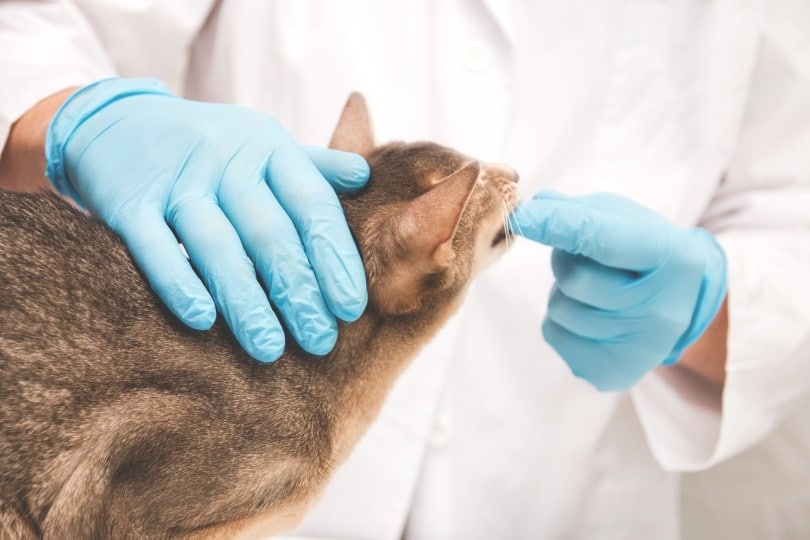
14. Progressive Retinal Atrophy
Persian and Abyssinian cats are the only breeds vulnerable to an inherited form of progressive retinal atrophy. The disease occurs when the retina’s photoreceptor cells develop abnormally and cause blindness. In most cases, the eyes’ rods fail first and cause the cat to lose night vision, but the animal becomes completely blind when the cones degenerate.
Although the disease leads to blindness in 1 or 2 years, retinal atrophy is not painful to cats. Removing obstacles in the home and assisting the cat with its handicap can help it enjoy a more comfortable life. Unfortunately, there are no successful treatments for progressive retinal atrophy.
15. Feline Hyperesthesia Syndrome
Cats that scratch or bite their backs near their tails may be going after irritating fleas, but when the behavior is excessive and combined with other symptoms, the diagnosis could be feline hyperesthesia syndrome. Besides scratching or biting, other symptoms of the condition include excessive tail-chasing, dilated pupils, aggression, urinating away from the litter box, and crying out.
Veterinarians previously believed the syndrome was related to obsessive-compulsive disorder, but some vets now think it’s associated with seizures. Doctors can prescribe medications to make the skin less sensitive, but pet parents also have to monitor the cat to ensure it does not harm itself by scratching the same area.
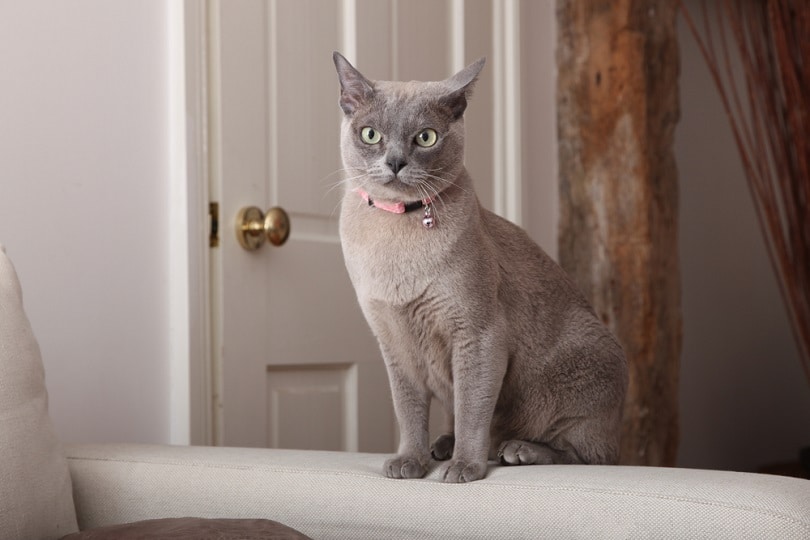
16. Shaft Disorder
All breeds can develop skin conditions, but shaft disorder is a rare genetic disease that only affects Abyssinian cats. Before diagnosing a cat with shaft disorder, the veterinarian will examine its skin closely for evidence of mites or fungal infections. The condition causes the Abyssinian’s primary fur to become brittle and dull, leading to bald spots and broken whiskers. Doctors can prescribe skin medications to treat shaft disorders, but luckily, it’s not a fatal disease.
17. Psychogenic Alopecia
Psychogenic alopecia is a compulsive disorder that can cause damage to the cat’s coat and skin when it overgrooms and pulls out large pieces of fur. Hypersensitive skin, mites, and fleas can cause similar symptoms, but veterinarians will perform tests to ensure the problem is behavioral rather than medical. Establishing a routine feeding schedule, increasing play sessions with the cat, and rewarding the animal when it refrains from overgrooming can ease its anxiety and reduce the behavior. Abyssinians and Siamese are more prone to psychogenic alopecia than other breeds.
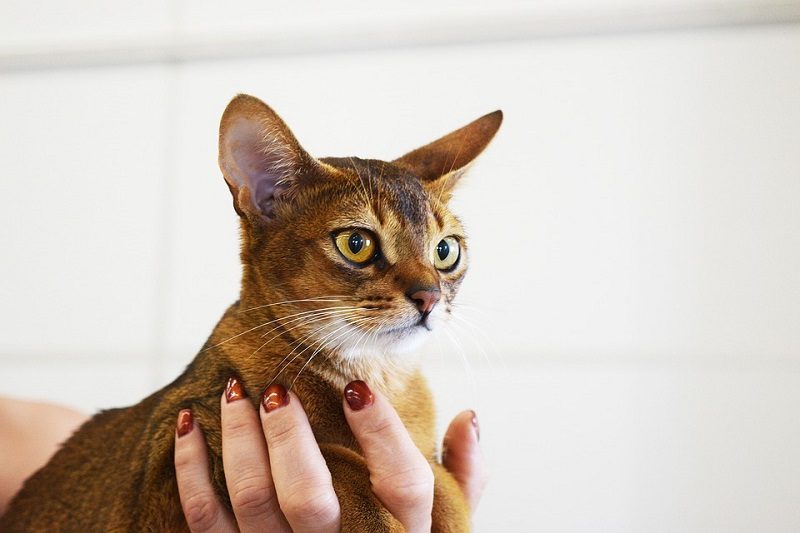
Conclusion
Although the number of possible diseases that an Abyssinian can contract may seem overwhelming to owners, some medical conditions are preventable, and most are treatable. Abyssinians are exceptional cats that can live several happy years, but their propensity for disease requires owners to be vigilant with veterinary care. Bi-annual checkups, routine feeding with high-quality meals and clean water, and physical and mental stimulation can help the Abyssinian enjoy an active, healthy life.
See Also:
- How Big Does an Abyssinian Get? Average Weight & Growth Chart
- Black Abyssinian Cat: Pictures, Facts & History
Featured Image Credit: Darya Lavinskaya, Shutterstock
Contents
- The 17 Common Abyssinian Cat Health Problems
- 1. Dental Disease
- 2. Heart Disease
- 3. Arterial Thromboembolism
- 4. Cryptococcosis
- 5. Feline Infectious Peritonitis
- 6. Neonatal Isoerythrolysis
- 7. Pyruvate Kinase Deficiency
- 8. Increased Osmotic Fragility of Erythrocytes
- 9. Feline Lower Urinary Tract Disease (FLUTD)
- 10. Renal Failure
- 11. Amyloidosis
- 12. Patellar Luxation
- 13. Gingivitis
- 14. Progressive Retinal Atrophy
- 15. Feline Hyperesthesia Syndrome
- 16. Shaft Disorder
- 17. Psychogenic Alopecia
- Conclusion

